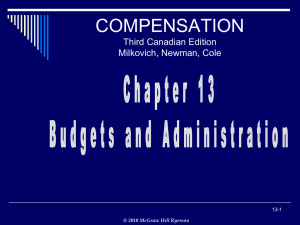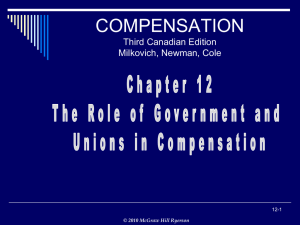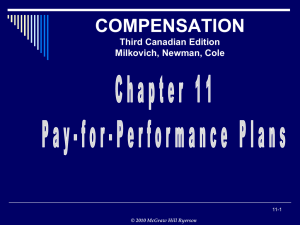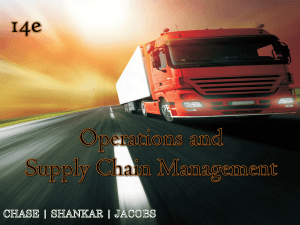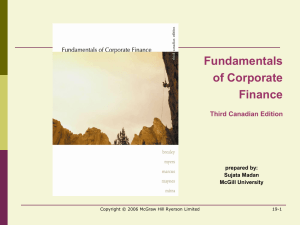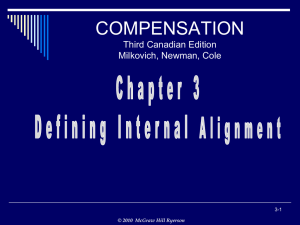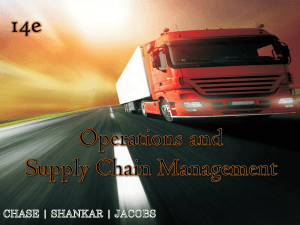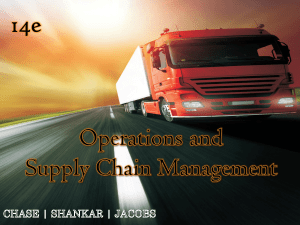Chapter 9 - Department of Business and Administration
advertisement
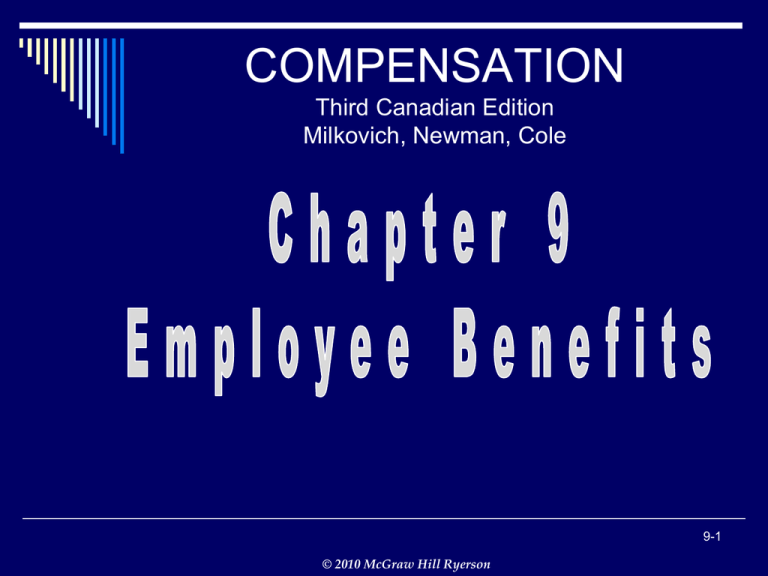
COMPENSATION Third Canadian Edition Milkovich, Newman, Cole 9-1 © 2010 McGraw Hill Ryerson Employee Benefits that part of the total compensation package, other than pay for time worked, provided to employees in whole or in part by employer payments (e.g., life insurance, pension plan, workers’ compensation, vacation) 9-2 © 2010 McGraw Hill Ryerson Why the Growth in Employee Benefits? Cost Effectiveness of Benefits Employer Impetus Unions Government Impetus 9-3 © 2010 McGraw Hill Ryerson Key Issues In Benefits Planning, Design, and Administration Establish plan objectives Integrate benefits with other compensation components Ensure external competitiveness Ensure adequacy of benefits Benefits Administration Who should be covered? How much choice for employees? How should benefits be financed? 9-4 © 2010 McGraw Hill Ryerson Financing Benefits Plans: Alternatives Non-contributory employer pays total costs Contributory costs shared between employer and employee Employee-financed employee pays total costs for some benefits 9-5 © 2010 McGraw Hill Ryerson Factors Influencing Choice of Benefits Package Employer Factors 1. 2. 3. 4. 5. 6. Relationship to total compensation costs Costs relative to benefits Competitor offerings Role of benefits in attraction, retention, motivation Legal requirements Absolute and relative compensation costs Employee Factors Benefits Package 1. Fairness in relationship to what others receive 2. Personal needs as linked to demographic characteristics such as age 9-6 © 2010 McGraw Hill Ryerson Flexible Benefits: Advantages employees choose packages that best satisfy their unique needs flexible benefits help firms meet the changing needs of a changing workforce increased involvement of employees and families improves understanding of benefits flexible plans make introduction of new benefits less costly cost containment - organization sets dollar maximum; employee chooses within the constraint 9-7 © 2010 McGraw Hill Ryerson Flexible Benefits: Disadvantages employees make bad choices and find themselves not covered for predictable emergencies administrative burdens and expenses increase adverse selection - employees pick only the benefits they will use; the subsequent high benefit utilization increases its cost 9-8 © 2010 McGraw Hill Ryerson Administering the Benefits Program communicating the benefits program claims processing cost containment 9-9 © 2010 McGraw Hill Ryerson Cost Containment probationary periods benefit maximums coinsurance deductibles coordination of spousal benefits administrative cost containment 9-10 © 2010 McGraw Hill Ryerson Categorization of Employee Benefits 1. Legally required payments 2. Retirement and savings plans 3. Life insurance benefits 4. Medical insurance 5. Income security benefits 6. Pay for time not worked 7. Miscellaneous benefits 9-11 © 2010 McGraw Hill Ryerson Workers’ Compensation a mandatory, government-sponsored, employer-paid no-fault insurance plan that provides compensation for injuries and diseases that arise out of, and while in the course of, employment provides benefits for Lost earnings due to temporary disability Lost earnings due to permanent disability Health care expenses Survivor benefits after fatalities 9-12 © 2010 McGraw Hill Ryerson Workers’ Compensation completely employer funded regulated by provinces/territories compensation varies from 75 to 90 percent of net earnings (two jurisdictions provide 75 percent of gross earnings) cost control is an ongoing concern 9-13 © 2010 McGraw Hill Ryerson Canada/Quebec Pension Plan a mandatory, government-sponsored pension plan for all employed Canadians funded equally by employers and employees provides benefits upon retirement disability death 9-14 © 2010 McGraw Hill Ryerson Employment Insurance a mandatory government-sponsored plan for all employed Canadians that provides workers with temporary income replacement as a result of employment interruptions due to circumstances beyond their control funded by employer and employee contributions basic benefit is 55 percent of average insurable earnings 9-15 © 2010 McGraw Hill Ryerson Employer-Sponsored Pension Plans plans that provide income to an employee at retirement as compensation for work performed now Defined benefit plans: employer agrees to provide a specific level of retirement pension, the exact cost of which is unknown Defined contribution plans: employer agrees to provide specific contributions but the final benefit is unknown 9-16 © 2010 McGraw Hill Ryerson Relative Advantages of Different Pension Alternatives DEFINED BENEFIT PLAN 1. Provides an explicit benefit which is easily communicated DEFINED CONTRIBUTION PLAN Unknown benefit level is difficult to communicate 2. Company absorbs risk Employees assume these risks associated with changes in inflation and interest rates which affect cost 3. More favourable to long service employees More favourable to short-term employees 4. Employer costs unknown Employer costs known up front 9-17 © 2010 McGraw Hill Ryerson Life Insurance group life insurance accidental death and dismemberment insurance dependant life insurance optional, employee-paid insurance retiree life insurance 9-18 © 2010 McGraw Hill Ryerson Employer-Sponsored Medical Plans cover expenses not payable under provincial/territorial plans prescription drug coverage considered most important benefits by employees medical cost control is biggest issue facing benefits managers today cost control through deductibles, coinsurance… preventive health care/wellness programs 9-19 © 2010 McGraw Hill Ryerson Income Security Benefits Short-term disability plans provide continuation of part or all of earnings during absence due to non-work related illness or injury Sick leave plans provide specified number of paid sick days per month or per year Long-term disability plans provide continuation of part of earnings during long-term absence due to non-work related illness or injury claims and costs rising sharply psychiatric disabilities fastest-growing 9-20 © 2010 McGraw Hill Ryerson Pay for Time Not Worked Paid rest periods, coffee breaks, travel time… vacations holidays leaves bereavement leave jury duty … 9-21 © 2010 McGraw Hill Ryerson Employee Assistance Plans (EAPs) provide confidential counselling and/or treatment programs for personal problems including addiction, stress, and mental health issues 9-22 © 2010 McGraw Hill Ryerson Conclusion employee benefits are a major cost of doing business cost savings on existing benefit packages will come from tighter administrative controls, and from benefit reductions 9-23 © 2010 McGraw Hill Ryerson
